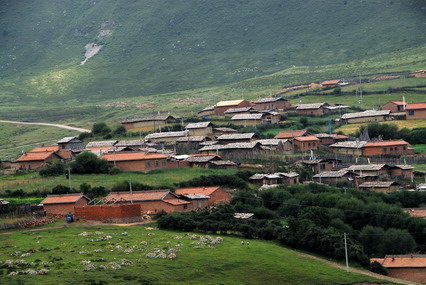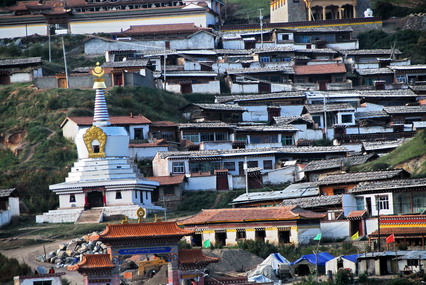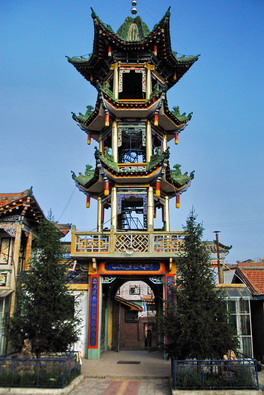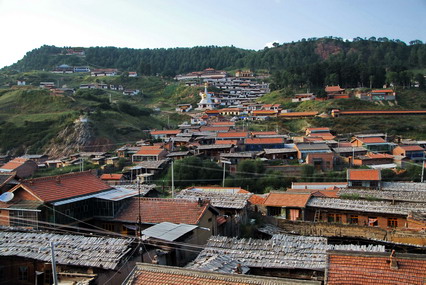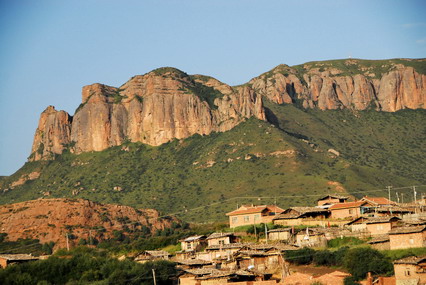Hereunder are some photos of Langmusi town taken by Zhaoyahui, a reporter from People's Daily on August, 2007 during his three-month tour in northwest China.
An ideal destination for backpackers as it has not been listed on the itinerary of any Chinese travel agency: a quiet, picturesque Tibetan village at an elevation of 3300 m, beautiful landscape, well preserved Tibetan cultures, unknown to most tourists. Daily life is regulated by Tibetan religious rituals. Curious travelers are even allowed to witness a sky-burial ceremony.
Langmusi has two monasteries located on the border of western provinces of Gansu and Sichuan. Sezhi Monastery (色止寺) is in Sichuan Province and Geerdeng Monastery (格尔登寺) in Gansu Province. Locals simply call them Sichuan Monastery and Gansu Monastery . Majestic temples with red wall and golden roof built on the slopes overlook hundreds of monks' houses painted in white with plank roof in the lower valley. Tibetan farms are dispersed outside the village. Prayers go around the monastery every day, from prayer wheels to sacred pagodas, kissing significant walls. Life goes on at a slow pace as hundreds of years ago.
A wonderful trek in Namo Gorge
For backpackers, Langmusi offers great possibilities for hiking. Sauntering up foothills by any of the trails and roads used by prayers and farmers, you can always enjoy a pleasant view over the monasteries, grassland and mountains. The most attractive trek is no doubt in the Namo Gorge lying to the east of the village.
Follow the stream up from the village, you will pass a beautiful school. The valley narrows and gives way to the steep alpine mountains. In front of a sacred cave under a cliff decorated by Tibetan flags, pass a board bridge over the stream, and go up to a small turquoise pond formed by a dam. The trail entering the gorge starts at the right bank of the pond which might be submerged by water after a storm.
The first part of the gorge is deep and narrow, 10 to 20 meters wide. Sometimes it is inevitable to pass the stream by foot. The water is chilly. After a half-an-hour walk, you can reach an open valley drenched with sunshine. This place is so wild and quiet. Lying on the meadow, I felt myself sliding into an old sweet dream of nature. “Life seems neither long nor short, and we take no more need to save time or make haste than do the trees and stars,” (-- by John Muir, Mr First Summer in the Sierra.)
From here, the valley is separated into two. We saw two travelers hiking back from the left valley. We decided to follow the creek up into the right valley. A Tibetan prayer's house can be reached in less than one hour's walk.
Getting there and away
Langmusi is on the itinerary of the backpackers who head from southwest China (Sichuan Province) to north china (Gansu Province) in order to access the legendary silk road.
Zoige(Sichuan) --> Langmusi --> Hezuo(Gansu)
> Buses from Zoige to Hezuo pass by the intersection beside a bridge (locals call it Qiaotou) between 10:00am to 11:00am. Then three-wheel trucks will give you a lift into Langmusi for Y2 or Y3.
> Langmusi has direct bus leaving for Hezhuo every day.
In Zoige, there are two bus stations. We bought the tickets for Langmusi with a seat number at one station. While getting on the bus, we found that our seats were occupied by locals who claimed having bought the same seats from another bus station. Each bus station sells its own tickets. Normally there are not enough people, so they would just dispatch one bus from one station and pick up the travelers from another station. Nobody knows in advance which station the bus would leave first. It's better to arrive at the bus station half an hour in advance.
Hezuo --> Langmusi --> Zoige
The Zoige Bus from Hezuo arrives at the intersection near Langmusi between 12:00 am and 1:00 pm. When we went back to Zoige, Our hotel advised recommended us to wait at the intersection at 11:00am. But the truck driver brought us to the town several km away from the interaction and said it would be much easier to find a bus to Zoige. Actually there were some mini-taxis from this town to Zoige, the driver would leave after he finds five to six passengers.
New: Hezuo has direct bus to Langmusi which leaves from the north bus station every morning. It takes around 4 hours.
Xiehe --> Hezuo: Frequent bus, Y20, 2 hours.
Where to stay
Simple lodges offer beds for Y15.- with English signs. We stayed at Langmusi Hotel (Bin1guan3) which has a shared hot shower room. Their toilets can be flushed. Four beds in a room. It was fully occupied that night. Difficult to judge how often they would change the sheets. But I have to admit that the room is relatively clean, no unexpected visitors (fleas or other insects) during the night.
New: Sana Hotel 萨娜宾馆: Tel 0941-6671062. Recommended by a traveler who visited Langmusi in July 2004. Located after Lesha's Cafe on the main road to the temples, Sana Hotel has rooms for Y15 -20 per bed. Bed sheets and shared bathroom are clean. Some rooms even offer nice views of the temple.
Where to eat
Lesha's Coffee is located on the way to the monasteries along the river. It seemed all the backpackers dined there as I had never seen any Westerner at other restaurants. Maybe because it is the only restaurant offering apple pies, yak bergers and chips in the town. It is said that Lesha met an American backpacker who got entirely soaked after exploring the Namo Gorge in the rain. Lesha dried his clothes and offered him hot meals. In return, this American made an apple pie for Lesha.
When to visit
From April to November. I first saw the photos of Langmusi on a Chinese travel magazine which had been taken at a Buddhist festival in winter. Monks' red robes contrasted beautifully with the white snow.
Tips from other travelers
Chris (March 2004): "I was there 3 years ago and I really like the place, except I spent too little time there. If your timing is right, you can take the bus from Langmusi town to Hezuo instead of waiting at Qiaotou for passing buses. The bus leaves from outside Langmusi Binguan (I think that's the name of the hotel I stayed. It's at the junction very near to Lesha's). The bus departs early in the morning, like 7.30 am or something. I recalled the bus only runs on certain days in the week. The people at the hotel can provide the info. Try Lesha's chocolate 'pie'. A whole bar of chocolate between 2 slabs of pastries. Really delicious."
Link:
Langmusi,where for backpackers (I)
Langmusi,where for backpackers (II)
Langmusi,where for backpackers (III)
Langmusi,where for backpackers (IV)
Langmusi,where for backpackers (V)
Related travelogue: The Pilgrims of Langmusi
(chinabackpacker.com October 10, 2007)


